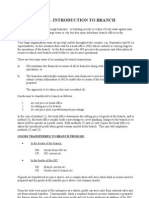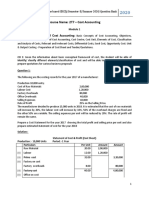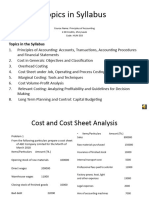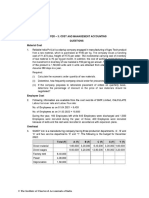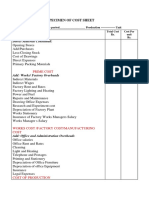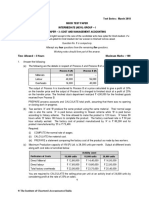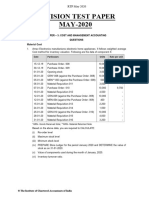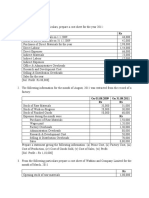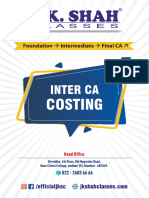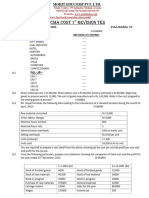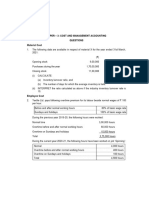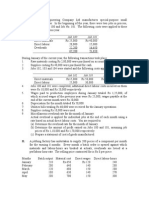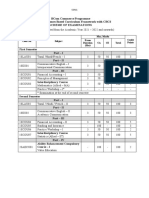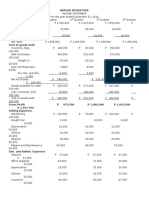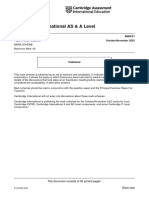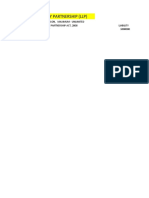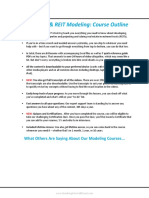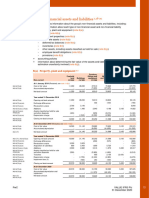Cost Accounitng - Problems
Uploaded by
21BCO021 Karthi VCost Accounitng - Problems
Uploaded by
21BCO021 Karthi VCourse Code 18COU08
Title COST ACCOUNTING
Class II B.Com Semester III
Course The course aims to
Objectives • Develop knowledge on Costing Concepts.
• Provide knowledge for Controlling Material Cost in a Manufacturing
Sector.
• Build knowledge on Labour Cost and Overheads.
• Impart knowledge about different Methods of Costing for various
Industries.
• Gain an understanding about Process Costing and Reconciliation
Statement.
No. of
UNIT Content
Hours
Introduction
Cost Accounting – Meaning, Scope and Objectives – Cost Concepts and
Classifications – Cost unit – Cost Centre – Financial Accounting and Cost
I 12
Accounting – Advantages – Limitations – Methods of Costing – Elements
of Cost – Collection of Cost – Classification of Cost as per CAS-1 - Cost
Statement – Tenders and Quotations.
Material Control
Material Control – Meaning – Need - Techniques of Material Control –
II Purchase and Inventory Control of Material – Methods of Valuing 15
Material Issues – FIFO – LIFO - Simple Average – Weighted Average –
Standard Price – Introduction to CAS-6.
Accounting for Labour Cost and Over heads
Labour – Computation of Labour Cost – Accounting for Overtime – Idle
Time and Labour Turnover – Good Wage System – Methods of
III 15
Remuneration - Time Rate – Piece Rate- Incentive Schemes – Introduction
to CAS-7. Overheads Allocation – Apportionment and Absorption –
Machine Hour Rate. Introduction to CAS-3.
Methods of Costing, Cost Reports and Cost Audit
IV Operating Costing – Unit Costing – Job and Contract Costing – Cost 15
Reports, Cost Audit.
Process Costing and Reconciliation of Cost & Financial Accounts.
Process Costing –Normal Loss – Abnormal Loss – Abnormal Gain - Inter
V 15
Process Profit – Accounting of By Products and Joint Products –
Reconciliation of Cost and Financial Accounts.
Distribution of Marks:80% Problems and 20% Theory
1
References Text Book
1. Jain .S.P. and Narang .K.L, “Cost Accounting”, 25th Ed., Kalyani
Publishers, New Delhi, 2016.
Reference Books
1. Sharma R.K. Shashi. Gupta “Management Accounting Principles and
Practice”, 7th Ed., Kalyani Publishers, New Delhi, 2016.
2. Maheswari.S.N. Suneel K.Maheswari CA Sharad K.Maheswari, “
Accounting for Management”, 3rd Ed., Vikas Publication, New Delhi, 2014.
Course On completion of the course, students will be able to
Outcomes CO1: Apply the Costing Concepts.
CO2: Identify Appropriate Methods to control the Material Wastage.
CO3: Apply the Suitable Methods for calculating the wages for labourers.
CO4: Prepare Cost Report.
CO5: Apply the knowledge for preparing Reconciliation Statement.
2
Unit – I
Cost Sheet - Problems
Problem No.1
Calculate Prime Cost, Factory Cost, Cost of Production, Cost of Sales and profit from the
following particulars:
Particulars Rs. Particulars Rs.
Direct Materials 1,00,000 Consumable stores 2,500
Direct Wages 30,000 Manager’s Salary 5,000
Wages of Foreman 2,500 Directors’ fees 1,250
Electric power 500 Office Stationery 500
Lighting: Factory 1,500 Telephone Charges 125
Office 500 Postage and Telegrams 250
Storekeeper’s wages 1,000 Salesmen’s salary 1,250
Oil and water 500 Travelling expenses 500
Rent: Factory 5,000 Advertising 1,250
Office 2,500 Warehouse charges 500
Repairs and Renewals: Sales 1,89,500
Factory plant 3,500 Carriage outward 375
Transfer to Reserves 1,000 Dividend 2,000
Depreciation: Factory Plant 500 Discount on shares written off 500
Office 1,250
Premises
Problem No.2
A manufacturer presents the following details about the various expenses incurred
Particulars Amount Particulars Amount
Raw materials consumed 70,000 Postage expenses 465
Carriage inwards 2,000 Repairs of plant & machinery 1,200
Factory rent 2,400 Salesmen’s expenses 3,400
Bad debts 440 Advertising 500
Printing and stationery 620 Direct wages 85,000
Legal expenses 350 General manager’s salary 36,000
Carriage outwards 1,540 Factory manger’s salary 18,000
Indirect materials 560 Depreciation of Plant & machinery 1,240
Power 4,600 Audit fees 350
Depreciation of furniture 160
Classify the above expenses under the various elements of cost showing separately the
total expenditure under each element
3
Problem No.3
From the following particulars, prepare a cost statement showing the total cost
1.1.2017 31.12.2017
Stock of finished goods 6,000 15,000
Stock of raw materials 40,000 50,000
Work-in-progress 15,000 10,000
Purchase of raw materials 4,75,000 Sales for the year 8,60,000
Carriage inwards 12,500 Income tax 500
Wages 1,75,000 Dividend 1,000
Works manager’s salary 30,000 Debenture interest 5,000
Factory employees’ salary 60,000 Tr to sinking fund 10,000
Factory rent, taxes and insurance 7,250 Goodwill written off 10,000
Power expenses 9,500 Payment of sales tax 16,000
Other production expenses 43,000 Selling expenses 9,250
General expenses 32,500
Problem No.4
Calculate the following Cost of raw-materials consumed, Prime Cost, Factory Cost ,
Cost of Production, Cost of Sales and Profit from the following particulars
Opening Stock
Raw-materials 2,00,000
Finished goods 1,60,000
Closing Stock
Raw-materials 1,60,000
Finished goods 2,00,000
Rawmaterials-purchased 20,00,000
Wages paid to labourers 8,00,000
Chargeable expenses 80,000
Rent, rates and taxes 2,00,000
Power 96,000
Factory heating and lighting 80,000
Factory insurance 40,000
Experimental expenses 20,000
Sale of wastage of material 8,000
Office management salaries 1,60,000
Office printing and stationery 8,000
Salaries of salesman 80,000
Commission of travelling agents 40,000
Sales 40,00,000
4
Problem No.5
The following data relate to the manufacturing of a standard product during the month of
January 2018
Particulars Amount
Raw materials consumed Rs.20,000
Direct wages Rs.12,000
Machine hours worked 1,000 hours
Machine hour rate Rs.2 per hour
Office overheads 20% on works costs
Selling overheads Re.0.40 per unit
Units produced 20,000 units
Units sold at Rs.3 per unit 18,000 units
Prepare a cost sheet to show (i) Prime cost (ii) Works cost (iii) Cost of production (iv)
Cost of production of goods sold (v) Cost of sales (vi) Profit
Problem No.6
The following data related to the manufacturer of a product during the month of September
2019, You are required to prepare cost sheet
Raw materials consumed Rs.40,000
Direct wages Rs.24,000
Machine hours worked 4,000 hours
Machine hour rate Rs.2 per hour
Administrative overheads 5% of works cost
Selling overheads Re.0.75 per unit
Units produced and sold 2,000 units
Selling price per unit Rs.40
Problem No.7
M/s Deepam furnishes the following data relating to the manufacturer of a standard product
during the month of April 2019.You are required to prepare a statement showing cost and profit
per unit
Raw materials consumed Rs.15,000
Direct labour charges Rs.9,000
Machine hours worked 900 hours
Machine hour rate Rs.5
Administrative overheads 20% on works cost
Selling overheads Re.0.50 per unit
Units Produced 17,100
Units sold 16,000 units @ Rs.4 per unit
5
Problem No. 8
Prepare cost sheet from the following particulars:
Raw material purchased Rs. 2,40,000
Freight charges paid Rs 20,000
Wages paid to labourers Rs.70,000
Factory on cost 20% of prime cost
General and administrative expenses 4% of factory cost
Selling and distribution expenses 5% of production cost
Profit 20% on sales
Tenders and Quotations
Problem No. 9
A factory uses job costing. The following cost data is obtained from its books for the
year ended 31st December 2019
Direct Materials Rs.90,000 Selling & Distribution Overhead Rs.52,500
Profit Rs.60,900 Administrative overheads Rs.42,000
Direct wages Rs.75,000 Factory Overheads Rs.45,000
(a) Prepare a job cost sheet indicating Prime cost, Works costs, Production cost, Cost of sales
and the sales value.
(b) In 2020, the factory receives an order for a number of jobs. It is estimated that direct
materials required will be Rs.1,20,000 and direct labour will cost Rs.75,000. What should be
the price for these jobs if the factory intends to earn the same rate of profit on sales assuming
that selling and distribution overheads have gone up by 15%? The factory recovers factory
overheads as a percentage of direct wages and administrative overheads as a percentage of
works cost, based on cost rates prevailing in the previous year.
Problem No.10
The accounts of a machine manufacturing company discloses the following information for six
months ending 31st December 2019
Material used Rs.1,50,000 Factory overhead Rs.24,000
Productive wages Rs.1,20,000 General expenses Rs.17,640
Prepare a cost sheet of the machine and calculate the price which the company should quote for
the manufacturing of a machine requiring materials valued at Rs.1,250 and productive wages
Rs.750, so that the price might yield a profit of 20% on selling price.
Problem No.11
Prepare a statement showing cost and profit from the information given below
a) Material consumed b) Prime Cost c) Works cost d) Cost of Production
e) Cost of sales f) Profit g) Sales
Material purchased 2,00,000 Wages 1,00,000
Opening stock of materials Rs.40,000 Direct expenses 20,000
Closing stock of materials Rs.60,000
• Factory overheads are absorbed at 20% on wages.
• Administrative overheads is 25% on the works cost
• Selling and distribution overheads are 20% on the cost of production
• Profit is 20% on sales
6
Problem No. 12
The following data have been extracred from the books of sunshine Industries Ltd for the year
2021
Particulars Amount Particulars Amount
Opening stock of Raw materials 25,000 Indirect consumption of Materials 500
Purchase of Raw materials 85,000 Salary – office 2,500
Closing stock of Raw materials 40,000 Salary – Salesmen 2,000
Carriage Inward 5,000 Other factory expenses 5,700
Direct wages 90,000 Other office expenses 900
Indirect wages 10,000 Manager’s Remuneration 12,000
Factory rent and rates 5,000 Bad debts written off 1,000
Office rent and rates 500 Advertisement expenses 2,000
Depreciation of Plant & Machinery 1,500 Travelling expenses 1,100
Depreciation of Furniture 100 Carriage outward 1,000
Cash Discount 5,000 Sales 2,50,000
Advanced Income Tax paid 15,000
The manager has overall charge of the company and his remuneration is to be allocated as
Rs.4,000 to factory, Rs.2,000 to office and Rs.6,000 to Selling operation
From the above particulars prepare a statement showing Prime Cost, Factory Cost, Cost of
Production, Cost of Production of Goods Sold, Cost of Sales and Profit
Problem No. 13
Following information has been obtained from the records of a Manaufacturing company
01–01–2020 31-12-2020
Stock of Raw Materials 40,000 50,000
Stock of Finished Goods 1,00,000 1,50,000
Stock of Work-in-Progress 10,000 14,000
Indirect labour 50,000 Administrative expenses 1,00,000
Lubricants 10,000 Power 30,000
Insurance of plant 3,000 Direct Labour 3,00,000
Purchase of Raw materials 4,00,000 Depreciation on Machinery 50,000
Sales commission 60,000 Factory Rent 60,000
Salaries to salesmen 1,00,000 Property Tax on Factory 11,000
Building
Carriage outward 20,000 Sales 12,00,000
Prepare statement of cost and profit showing cost of raw materials consumed, Prime cost,
Factory cost, Cost of Production, Cost of Production of goods sold, Cost of Sales and Profit
Problem No. 14
7
A manufacturing company requires a statement showing the result of its production operation for
September 2021. Cost records gives the following information
1st September 2021 30th September 2021
Stock of Raw Materials 1,00,000 1,23,500
Stock of Finished Goods 71,500 42,000
Stock of Work-in-Progress 31,000 34,500
Transactions during the month of September 2021 are
Purchase of raw materials 88,000 Sale of Factory scrap 2,000
Direct wages 70,000 Selling & Distribution Expenses 15,000
Work Expenses 39,500 Sales 2,84,000
Administrative Expenses 13,000
8
Unit - II
MATERIAL COSTING
Problem No. 1
Calculate the minimum stock level, maximum stock level, re-ordering level and average stock
level from the following information:
Minimum consumption - 100 units perday
Maximum consumption - 150 units perday
Normal consumption - 120 units perday
Re-order period - 10-15days
Re-order quantity - 1,500units
Normal re-order period - 12 days
Problem No. 2
Two components X and Y are used as follows:
Normal usuage - 600 units per week each
Maximum usuage - 900 units per week each
Minimum usuage - 300 units per week each
Reorder quantity - X - 4,800 units Y - 7,200 units
Reorder period - X - 4 to 6 weeks Y - 2 to 4 weeks
Calculate for each components
a) Reorder level b) Minimum stock level c) Maximum stock level d) Average stock
level
Problem No. 3
Two materials A and B are used as follows
Normal consumption - 50 units per week each
Minimum consumption - 25 units per week each
Maximum consumption - 75 units per week each
Reorder quantity - A – 300 units B – 500 units
Reorder period - A – 4 to 6 weeks B – 2 to 4 weeks
Calculate a) Re-order level b) Minimum stock level
c) Maximum stock level d) Average stock level
Problem No.4
Two components A and B are used as follows
Normal usage - 3,000 units per week each
Minimum usage - 1,500 units per week each
Maximum usage - 4,500 units per week each
Reorder quantity - A – 13,000 units B – 14,000 units
Reorder period - A - 4 to 6 weeks B – 2 to 4 weeks
Calculate a) Re-order level b) Minimum stock level
c) Maximum stock level d) Average stock level
Problem No.5
Calculate the minimum stock level, maximum stock level, re-ordering level and average stock
level from the following information:
Minimum consumption - 100 units perday
Maximum consumption - 175 units perday
9
Normal consumption - 125 units perday
Re-order quantity - 1,500units
Minimum period for receiving goods - 7 days
Maximum period for receiving goods - 15 days
Normal period for receiving goods - 10 days
Problem No.6
Calculate Economic order quantity:
Annual consumption - 600 units Order cost - Rs.12 per order
Cost per unit - Rs.20 Storage & Carrying - 20% on cost per
unit
Problem No.7
Calculate Economic order quantity:
Annual consumption - 20,000 units Buying cost per order - Rs.10 per order
Cost per unit - Rs.100 Storage & Carrying - 10% of cost
Problem No.8
Calculate Economic order quantity:
Annual consumption - 90,000 units Cost per unit - Rs.50
Buying cost per order - Rs10 Cost of carrying inventory - 10% of
cost
Problem No.9
From the following information calculate (a) Economic Order Quantity and (b) the number
of orders to be placed in one quantity of the year
Quarterly consumption of material - 2,000 kgs Annual consumption – 8,000
Kgs
Cost of placing one order - Rs.50
Cost per unit - Rs.40
Storage and carrying cost - 8% on average inventory
Problem No.10
Calculate (a) EOQ (b) Maximum (c) Minimum level and (d) Reordering level from the
following data
Re-order period - 4 to 6 weeks
Maximum consumption - 100 units per week
Minimum consumption - 50 units per week
Normal consumption - 75 units per week
Annual consumption - 36,000 units
Cost per unit - Re.1
Ordering cost - Rs.25 per order
Inventory carrying cost is 20% of unit value.
10
PRICING OF MATERIAL ISSUE
Problem No.1
The stock in hand of material as on 1st September 2018 500 units at Re.1 per unit. The
following purchase and issue were subsequently made. Prepare the stores ledger account
showing how the value of the issues would be recorded under (a) FIFO and (b) LIFO
method
Purchased Issued
th th
6 September 100 units @ Rs.1.10 9 September 500 units
20th September 700 units @ Rs.1.20 22nd September 500 units
th th
27 September 400 units @ Rs. 1.30 30 September 500 units
13th October 1,000 units @ Rs.1.40 15th October 500 units
th nd
20 October 500 units @ Rs.1.50 22 October 500 units
th th
17 November 400 units @ Rs.1.60 11 November 500 units
Problem No.2
The following transactions occur in the purchase and issue of materials
Jan 2 Purchased 4,000 units @ Rs.4 per unit
20 Purchased 500 units @ Rs.5 per unit
Feb 5 Issued 2,000 units
10 Purchased 6,000 units @ Rs.6 per unit
12 Issued 4,000 units
March 2 Issued 1,000 units
5 Issued 2,000 units
15 Purchased 4,500 units @ Rs.5.50 per unit
20 Issued 3,000 units
From the above prepare stores ledger adopting FIFO and LIFO method
Problem No. 3
Prepare stores ledger account from the following information adopting FIFO and LIFO method
of pricing of issue of materials
2018 Jan 1 Opening balance 500 tonnes at Rs.25
3 Issue 70 tonnes
4 Issue 100 tonnes
8 Issue 80 tonnes
13 Received from vendor 200 tonnes at Rs.26
14 Refund of surplus 15 tonnes at Rs.25
16 Issue 180 tonnes
20 Received from vendor 240 tonnes at Rs.25
24 Issue 300 tonnes
25 Received from vendor 320 tonnes at Rs.28
26 Issue 112 tonnes
27 Refund of surplus 12 tonnes at Rs.27
28 Received from vendor 100 tonnes at Rs.29
11
Problem No. 4
The following information is extracted from the stores ledger
Jan 1 Opening Balance 500 units at Rs.4
5 Purchases 200 units at Rs.4.25
12 Purchases 150 units at Rs.4.10
20 Purchases 300 units at Rs.4.50
25 Purchases 400 units at Rs.4
Issue of materials were as follows
Jan 4 200 units Jan 10 400 units
15 100 units 19 100 units
26 200 units 30 250 units
Issues are to be paid on the principle of FIFO and LIFO method. Write up the
stores ledger account.
Problem No. 5
Show the Stores Ledger entries as they would appear when using a) Simple Average Method and
b) Weighted Average Method of pricing, in connection with the following transactions:
Units Price
April 1 Balance in hand b/f 300 2.00
2 Purchase 200 2.20
4 Issued 150 --
6 Purchased 200 2.30
11 Issued 150 --
19 Issued 200 --
22 Purchased 200 2.40
27 Issued 150 --
Problem No.6
Set up a stores ledger form and enter the following transactions adopting the Simple and
weighted average method of pricing out issues
July 2020, 1 Opening balance 50 units @ Rs.3 per unit
5 Issued out for production 2 units
7 Purchased 48 units @ Rs.4 per unit
9 Issued 10 units for production
19 Purchased 76 units @ Rs.3 per unit
24 Purchased 19 units @ Rs. 3.20 per unit
27 Issued to production 10 units
12
Problem No. 7
The standard price of a material is fixed at Rs.12 per unit. The following purchases and issues
were made during March 2020. Prepare the stores ledger account showing how the cost of
materials issued and value of balances in stock will be recorded under standard price method
Date Particulars Quantity Rate
March 3 Received 1,800 units Rs.12
8 Received 500 units Rs.14
15 Issued 1,000 units --
21 Received 600 units Rs.11
24 Issued 700 units --
28 Received 900 units Rs.13
30 Issued 850 units --
Problem No. 8
From the following details of stores receipts and issue of materials in a manufacturing unit,
prepare the stock ledger using LIFO, FIFO and weighted average method of valuing the issues
Nov 1 Opening stock 2000 units @ Rs.5 each
3 Issued 1,500 units to production
4 Received 4,500 units @ Rs.6 each
8 Issued 1,600 units to production
9 Returned to stores 100 units by production department (From the issue of
Nov 3)
16 Received 2,400 units @ Rs.6.50 each
19 Returned to supplier 200 units out of the quantity received on Nov 4
20 Received 1,000 units @ Rs.7 each
24 Issued to production 2,100 units
27 Received 1,200 units @ Rs.7.50 each
29 Issued to production 2,800 units
*************
13
Unit – III
Labour Cost and Overheads
Problems – Labour cost
Labour Turnover
Problems No.1
From the following data given by the personnel department. Calculate the labour turnover rate
by applying separation method, replacement method and Flux method.
Number of workers on the payroll:
At the end of the month - 900
At the beginning of the month - 1,100
During the month 10 workers left, 40 workers were discharged and 150 workers were
recruited. Of these 25 workers are recruited in the vacancies of those leaving, while the rest
were engaged for an expansion scheme.
Problem No.2
The extract from the payroll of a company gives the following information
Number of employees at the beginning of 2019 - 240
Number of employees at the end of 2019 - 310
Number of employees discharged during the year - 5
Number of employees resigned during the year - 26
Number of employees replaced due to quits and discharges- 25
Calculate labour turnover
Problem No.3
From the following information calculate the labour turnover rate:
Number of workers on the payroll:
At the end of the month - 3,800
At the beginning of the month - 4,200
During the year, 40 workers left while 160 workers are discharged. 600 workers are recruited
during the year of these 150 workers are recruited to fill up vacancies and the rest are engaged
on account of an expansion scheme.
Problem No. 4
The extracts from the payroll of M/s Maheswari Bros. is as follows
Number of employees at the beginning of 2019 - 150
Number of employees at the end of 2019 - 200
Number of employees resigned - 20
Number of employees discharged - 5
Number of employees replaced due to resignation and discharge is 20
Calculate the labour turnover rate for the factory under separation method
14
Problem No. 5
M/s R metal company gives the following information
Number of employees on 1.4.2018 - 200
Number of employees on 31.3.2019 - 240
Number of employees resigned - 20
Number of employees discharged - 5
Number of employees replaced - 18
Calculate the labour turnover under all three method
Problem No.6
From the following data, prepare a statement showing the cost per man day of eight hours
a) Basic salary and dearness allowance Rs.3,000 per month
b) Leave salary 6% of the basic and DA
c) Employee’s contribution to the PF 6% of (a) and (b)
d) Employers contribution to PF 6% of (a) and (b)
e) Number of working hours in a month 200
Problem No.7
From the following data, prepare a statement showing the cost per man day of eight hours
a) Basic salary and dearness allowance Rs.300 per month
b) Leave salary 6% of the basic and DA
c) Employer’s contribution to PF 6% of (a) and (b)
d) Employee’s contribution to PF 6% of (a) and (b)
e) Prorata expenditure on amenties to labour Rs.25 per head per month
f) Number of working hours in a month 200
Remuneration and incentives
Problem No.8
In a factory workers are paid at Rs.50 per hour. During the month of April 2020,
there were 25 working days of 8 hours each. There is also a piece work plan where in Rs.10
is to be paid per piece produced. During the month worker “X” produced on average 48
pieces per working day, “Y” produced on average 60 pieces per working day and “Z”
produced on average 72 pieces per working day Ascertain the wages of workers under
a) Time wages
b) Piece wages
Problem No. 9
A company employs workers on time wages cum piece wage basis. Workers get
payment as per the method more beneficial for them. During a week of 44 hours, production
was as under
Kannan - 125 units Ramu - 185 units
Time rate - Rs.5 per hour Piece rate - Rs.4 per unit
Calculate the earnings of each worker.
15
Problem No.10
Calculate the earnings of worker X and Y under a) Straight Piece rate and b)
Taylors’d differential piece rate system from the following details
Standard time per unit - 12 minutes
Standard rate per hour - Rs.60
Differentials to be used 80% and 120%
In a particular day of 8 hours, worker “A” Produced 30 units and Worker “B” produced 50
units.
Problem No.11
From the following information calculate the earnings of “A” and “B” under piece rate
system and under Taylor’s differential piece rate system
Standard time - 10 units per hour
Normal wages - Rs.10 per hour
Differentials to be applied
75% piece rate when below standard
125% of the piece rate when above standard
In a day of 8 hours “A” produced 60 units and “B” produced 100 units
Problem No.12
Calculate the earnings of worker A and B under straight piece rate system and Taylor’s
differential piece rate system from the following particulars
Normal rate per hour - Rs.2.40
Standard time per unit - 30 seconds
Differentials to be applied
80% of the piece rate below standard
120% of the piece rate at or above standard
Output Worker A – 800 units per day Worker B – 1,000 units per day
Problem No.13
Calculate the earnings of worker A and B under straight piece rate system and Taylor’s
differential piece rate system from the following particulars
Standard production - 7 units per hour
Normal rate per hour - Rs.2.80
Differentials to be applied
80% of the piece rate below standard
120% of the piece rate at or above standard
Output Worker A – 50 units per day Worker B –60 units per day
16
Problem No.14
Calculate the earnings of a worker under Halsey plan and Rowan plan
Standard time - 36 hours Actual time - 30 hours
Rate per hour - Rs.10
Problem No.15
Calculate the earnings of a worker “A” and “B” under Halsey plan and Rowan plan
Standard time - 10 hours Rate per hour - Rs.5
Time taken - A – 9 hours B- 8 hours
Problem No.16
Using the following data, calculate the earning of the worker under Halsey and Rowan plan
system
Time allowed - 48 hours Time taken - 40 hours
Rate per hour - Rs.5
Problem No.17
From the following particulars work out the earning for the week of a worker under
a) Straight piece rate
b) Taylor’s differential piece rate
c) Halsey premium system
d) Rowan system
Number of working hours per week - 48
Wages per hour - Rs.3.75
Rate per piece - Rs.1.50
Normal time per piece - 20 minutes
Standard output per week - 120 pieces
Actual output per week - 150 pieces
Differentials to be applied
80% of the piece rate below standard
120% of the piece rate at or above standard
Problem No.18
Merrick’s multiple piece rate system
Efficiency below 83% of standard output - ordinary piece rate
Efficiency 83% - 100% - 110% of the piece rate
Efficiency above 100% - 120% of the piece rate
Calculate earnings of three workers A, B and C under Merrick’s plan of piece rate system from
the following
Standard production - 120 units
Production “A” – 90 units “B” – 100 units “C” – 130 units
Ordinary piece rate - Re.0.10
17
Problem No.19
Calculate the earnings of A, B and C under straight piece rate system and Merricks multiple
piece rate system from the following particulars
Normal rate per hour - Rs.1.80 Standard time per unit - 1 minute
Output per day - A – 384 units B – 430 units C – 552 units
Working hours - 8 per day.
Problem No. 20
Calculate the earning of worker A, B and C under Merricks Multiple piece rate system from the
following
Standard production per day - 150 units
Normal piece rate - Re.0.50 per unit
Production of worker on a particular day
A – 120 units B – 140 units C – 160 units
Problem No. 21
From the particulars given below, calculate the labour cost per man-day of 8 hours:
a) Basic salary : Rs.5 per day
b) Dearness Allowance: 20 paise per every point over 100 cost of living index for workers –
current cost of Living Index 800 points
c) Leave salary 5% of (a) and (b)
d) Employer’s contribution to Provident Fund - 8% of (a) and (b)
e) Employer’s Contribution to State Insurance – 5% of (a), (b) and (c)
f) Number of working days in a month – 25 days of 8 hours each
Problems in Overhead Accounting
Problem No.1
Kumaresh Ltd. has three production department P1, P2 and P3 and two service departments S1
and S2. The following figures are extracted from the records of the company
Rent and Rates Rs.5,000 General Lighting Rs.600
Indirect wages Rs.1,500 Power Rs.1,500
Depreciation of machinery Rs.10,000 Sundries Rs.10,000
Following further details are available:
Total P1 P2 P3 S1 S2
Floor space(Sq. meters) 10,000 2,000 2,500 3,000 2,000 500
Light Points 60 10 15 20 10 5
Direct Wages (Rs.) 10,000 3,000 2,000 3,000 1,500 500
Horse Power of machinery 150 60 30 50 10 --
Value of machinery (Rs.) 2,50,000 60,000 80,000 1,00,000 5,000 5,000
Apportion the costs to various departments on the most equitable basis by preparing a
Primary Departmental Distribution Summary
18
Problem No.2
The following data were obtained from the books of Light Engineering Company for the half
year ended 31st March 2020
Production Department Service Department
P1 P2 P3 S1 S2
Direct wages Rs. 7,000 6,000 5,000 1,000 1,000
Direct Material Rs. 3,000 2,500 2,000 1,500 1,000
Employees Nos. 200 150 150 50 50
Electricity KWh 8,000 6,000 6,000 2,000 3,000
Light Point Nos. 10 15 15 5 5
Asset Values Rs. 50,000 30,000 20,000 10,000 10,000
Area occupied Sq. Mts 800 600 600 200 200
The expenses for 6 months were
Stores overhead Rs.400 Labour welfare Rs.3,000
Motive power Rs.1,500 Depreciation Rs.6,000
Electric Lights Rs.200 Repairs and Maintenance Rs.1,200
General overheads Rs.10,000 Rent and Taxes Rs.600
You are required to prepare Primary Overhead Distribution Summary for the departments
showing clearly the basis of apportionment where necessary.
Problem No.3
A Company’s production for the year ending 30.06.2020 is given below
Items Production department Service Department Total
P1 P2 P3 S1 S2 S3
Direct wages (Rs.) 20,000 25,000 30,000 -- -- -- 75,000
Direct Material (Rs.) 30,000 35,000 45,000 -- -- -- 1,10,000
Indirect Material (Rs.) 2,000 3,000 3,000 1,000 2,000 2,000 13,000
Indirect Wages (Rs.) 3,000 3,000 4,000 10,000 10,000 5,000 35,000
Area in Square Metres 200 250 300 150 100 250 1,250
Book Value of Machinery (Rs.) 30,000 35,000 25,000 -- -- 15,000 1,05,000
Total HP of machinery 15 20 25 -- -- 5 65
Machine Hours Worked 10,000 20,000 15,000 -- -- 5,000 50,000
General Expenses
Rent Rs.12,500 Insurance Rs.1,050
Light Rs.1,250 Power Rs.3,800
Depreciation 15% of value of machinery
You are required to prepare an overhead analysis sheet for the departments showing
clearly the basis of apportionment where necessary.
19
Problem No.4
The following particulars relate to a manufacturing company which has three productions
department P1, P2 and P3 and two service departments S1 and S2
P1 P2 P3 S1 S2
Total departmental overheads as per Primary 6,300 7,400 2,800 4,500 2,000
Distribution
The company decided to charge the service departments cost on the basis of following
percentages:
Production dept. Service dept.
Service departments P1 P2 P3 S1 (X) S2 (Y)
S1 40 % 30 % 20 % -- 10 %
S2 30 % 30 % 20 % 20 % --
Find the total overheads of production departments charging service departments’ cost to
production departments on (a) Repeated distribution method and (b) Simultaneous equation
method
Problem No. 5
In a factory there are two service departments S1 and S 2 and three productions
department P1, P2 and P3. In April 2020, the departmental expenses were
P1 P2 P3 S1 S2
Total departmental overheads as per 6,50,000 6,00,000 5,00,000 1,20,000 1,00,000
Primary Distribution
The service department expenses are allocated on a percentage basis as follows:
Production dept. Service dept.
Service departments P1 P2 P3 S1 S2
S1 30 % 40% 15% -- 15%
S2 40 % 30 % 25 % 5% ---
Find the total overheads of production departments charging service departments’ cost to
production departments on (a) Repeated distribution method and (b) Simultaneous equation
method
Problem No. 6
PH Ltd is a manufacturing company having three production departments P1 and P2 and P3 and
two service departments S1 and S2. The following is the budget for December 2019
Expenses Total P1 P2 P3 S1 S2
Direct materials 1,000 2,000 4,000 2,000 1,000
Direct wages 5,000 2,000 8,000 1,000 2,000
Factory Rent - 4,000
Power [ Mhrs * HP] 2,500
Depreciation 1,000
Other overheads -[Mhrs] / DW 9,000
Additional information
Area (sq. ft.) 500 250 500 250 500
20
Capital value (Rs. Lacs) of assets 20 40 20 10 10
Machine hours 1,000 2,000 4,000 1,000 1,000
Horse power of machine 50 40 20 15 25
A technical assessment for the apportionment of expenses of service department is as under:
Production dept. Service dept.
Service departments P1 P2 P3 S1 S2
S1 45 % 15% 30 % -- 10 %
S2 60 % 35 % -- 5% ---
Required
➢ A statement showing distribution of overheads to various departments
➢ A statement showing re-distribution of service departments’ expenses to production
departments.
Problem No. 7
Strongman Ltd. Has three production departments P1, P2 and P3 and two service
departments S1 and S2
The following particulars are available for the month of March 2020 concerning the organisation
Rent 15,000 Municipal taxes 5,000
Electricity 2,400 Indirect wages 6,000
Power 6,000 Depreciation on machinery 40,000
Canteen Expenses 30,000 Other Labour cost [DW] 10,000
Following further details are also available:
Expenses Total P1 P2 P3 S1 S2
Floor space (sq.mts) 5,000 1,000 1,250 1,500 1,000 250
Light points (Nos.) 240 40 60 80 40 20
Direct wages (Rs.) 40,000 12,000 8,000 12,000 6,000 2,000
Horse power of machine (Nos.0 150 60 30 50 10 --
Cost of machine (Rs.) 2,00,000 48,000 64,000 80,000 4,000 4,000
Working Hours ---- 2,335 1,510 1,525 --- ---
The expenses of service departments are to be allocated in the following manner
Production dept. Service dept.
Service departments P1 P2 P3 S1 S2
S1 20 % 30% 40 % -- 10 %
S2 40 % 20 % 30 % 10 % ---
You are requested to calculate the overhead absorption rate per hour in respect of the three
production departments
21
Machine hour rate
Problem No. 8
Calculate the Machine hour rate from the following
(i) Cost of machine Rs.19,200
(ii) Estimated scrap value Rs.1,200
(iii) Average repairs and maintenance charges per month Rs.150
(iv) Standing charges allocated to machine per month Rs.50
(v) Effective working life of machine 10,000 hours
(vi) Running time per month 166 hours
(vii) Power used by machine: 5 units per hour @ 19 paise per unit
Problem No.9
Calculate the machine hour rate for Machine A from the following data
(i) Cost of machine Rs.16,000
(ii) Estimated scrap value Rs.1,000
(iii) Estimate working life of machine 10,000 hours
(iv) Running time per 4 weekly period 160 hours
(v) Average cost of repairs and maintenance per 4 weekly period is Rs.120
(vi) Standing charges allocated to machine A per 4 weekly period is Rs.40
(vii) Power used by machine: 4 units per hour @ 5 paise per unit
Problem No.10
Calculate the machine hour rate for Machine A from the following data
(i) Cost of welding machine Rs.4,20,000
(ii) Estimated scrap value Rs.20,000
(iii) Estimate working life 10 years of 20,000 hours each
(iv) Running time per 4 weekly period 1500 hours
(v) Estimated repairs for life Rs.10,000
(vi) Standing charges allocated to this machine for four weeks Rs.3,000
(vii) Power consumed per hour – 5 units at Re.1 per unit
**************
22
UNIT – IV
METHODS OF COSTING, COST REPORTS AND COST AUDIT
OPERATING COSTING / SERVICE COSTING
Problem No.1
A transport company operates 4 buses on a route 100 kms long. Each bus makes three round
trips per day on all 30 days in a month. On an average 20% of the vehicles are in garage for
repairs and maintenance. Ascertain the total distance covered by the buses in one month period.
Problem No.2
City corporation employees 80 vehicles of 5 ton capacity for conservancy work. On an average
each vehicle makes 4 trips a day, covering a distance of 8 kms in each trip. Load actually carried
is 80% of the capacity, on average. On an annual average basis 20% of the vehicle are laid up
for maintenance on any given day. The vehicles run 30 days a month. Calculate the total tonne-
kms per month.
Problem No.3
Pallavan Transport Corporation runs the following fleet of buses within Chennai city
Capacity
50 Buses 50 Passengers
80 Buses 40 Passengers
On an average each bus makes 8 trips a day covering a distance of 10kms in each trip and the
average seat occupancy is 80%. On average 10% of the buses are kept away from roads for
maintenance and repairs. Calculate the effective passenger kms for the month of April 2019.
Problem No. 4
A lodging house has 2 kind of accommodation. 50 Deluxe rooms and 100 Janantha room, with
weightage for value of 3 and 1 respectively. During the busy season, 90% of Deluxe and 100%
of Janatha room are fully occupied, the season stretching upto 6 months. In the off season(the
other 6 months) the occupancy rates are 40% and 60% respectively for each category. Compute
the Room days on the basis of which rental rates can be fixed assuming a 360 days year.
Problem No. 5
A transport service company is running four buses between two towns which are 50 kms
apart. Seating capacity of each bus is 40 passengers. Actual passengers carried were 75% of the
seating capacity. All the four buses ran on all days of the month of April 2019. Each bus made
one round trip per day. Calculate the total kms and total passenger kms. For the month.
Problem No.6
City Bus service Ltd.. run the following fleet of buses within the limits of Delhi city.
Capacity
10 Buses 50 Passengers
15 Buses 40 Passengers
On an average, each bus makes 10 trips a day covering a distance of 8 kms in each trip and 75%
of the seats are occupied. The annual records show that 5 buses are generally required to be kept
23
away from road each day for repairs. Calculate the effective passenger kms. For the month of
March 2019.
Problem No. 7
A lorry starts with a load of 20 tonnes of goods from station A. It unloads 8 tonnes at station B
and rest of goods at station C. It reaches back directly to station A after getting reloaded with 16
tonnes of goods at station C. The distance between A to B, B to C and from C to A are 80 kms,
120 kms and 160 kms respectively. Compute Absolute tonnes kms and commercial tonnes kms.
Problem No. 8
Compute cost per running kilometer from the following data of a truck.
Estimate life of vehicle 1,00,000 kms. Annual running 15,000kms
Cost of vehicle Running expense (Depreciation) 25,000
Road license (Annual) Fixed expenses 750
Insurance (Annual) Fixed expenses 700
Garage rent (Annual) Fixed expenses 900
Supervision & Salaries (Annual) Fixed expenses 2,700
Drivers’ wages per hour Running expense 3
Cost of fuel per litre Running expense 3
Repairs and maintenance per km Maintenance charges 1.75
Tyre allocation per km Maintenance charges 0.90
Charge interest at 5% per annum on cost of vehicle. Fixed expenses
The vehicle runs 20 kms per hour on an average and one litre of fuel gives 20 km. Running
expense
Problem No.9
From the following data calculate the cost per km. of a vehicle
Value of vehicle - Depreciation – Running expenses Rs.15,000
Road license fee per year – Fixed expenses Rs.500
Insurance charges per year - Fixed expenses Rs.100
Garage rent per year - Fixed expenses Rs.600
Driver’s wages per month – Running expenses Rs.200
Cost of petrol per litre – Running expenses Re.0.80
Km. per litre 8
Proportionate charges for tyre and maintenance per km. Re.0.20
– Maintenance charges
Estimated life 150,000 kms
Estimated annual kilometers 6,000 kms
Ignore interest on capital
24
Problem No.10
Mr.Sachin furnishes you the following data, compute the cost per running km. of vehicle of A
Cost of vehicle – Depreciation – Running charges Rs.250,000
Road license (per year) – Fixed expenses Rs.800
Supervision and Salaries - Fixed expenses Rs.2,700
Driver’s wages per hour – Running charges Rs.4
Cost of fuel per litre – Running charges Rs.12
Repairs and Maintenance per km – Maintenance charges Rs.2
Tyre cost per km - Maintenance charges Re.1
Insurance Premium (Yearly) – Fixed expenses Rs.700
Garage rent (Per year) - Fixed expenses Rs.1,300
Kms. Run per litre – Running expenses 20
Kilometres run (during the year) 15,000
Tonnes per km (average) 6
Estimated life of the vehicle (Kms.) 1,00,000 kms
Charge interest at 5% per annum on cost of vehicle. Fixed expenses
The vehicle runs 20 kms per hour on an average.
Problem No.11
A transport service company is running five buses between two towns which are 50kms apart.
Seating capacity of each bus is 50 passengers. The following particulars were obtained from
their books for April 2019:
Wages of drivers, conductors and cleaners – Running expenses 24,000
Salaries of office staff – Fixed expenses 10,000
Diesel oil and other oil – Running expenses 35,000
Repairs and maintenance – Maintenance charges 8,000
Taxation, insurance, etc., - Fixed expense 16,000
Depreciation – Running expenses 26,000
Interest and other expenses – Fixed expenses 20,000
Total ----------
1,39,000
=======
Actually, passenger carried were 75% of seating capacity. All buses run on all days of the
month. Each bus made one round trip per day. Find out the cost per passenger km.
Problem No. 12
M/s JEE & Co. own fleet of taxis and the following information are available form the records
maintained by him:
Number of taxis 10
Cost of each taxi Rs.20,000
Salary of manager Rs.600 per month
Salary of accountant Rs.500 per month
Salary of cleaner Rs.200 per month
Salary of mechanic Rs.400 per month
Garage rent Rs.600 per month
25
Insurance premium 5% per annum
Annual tax Rs.600 per txi
Drivers’ salary Rs.200 per month per taxi
Annual repair Rs.1,000 per taxi
Total life of taxi is about 2,00,000 kms. A taxi runs in all 3,000 kms in a month of which 30% it
runs empty. Petrol consumption is 1 litre for 10kms @ Rs.1.80 per litre. Oil and other sundries
are Rs.5,000 per 100 kms. Calculate the cost of running a taxi per km.
UNIT COSTING
Problem No.1
M/s. Ramola products Ltd. Purchases Tin sheets for industrial use, all of standards size
and shape. For the quarter ended 30h September 2019, the following figures are available
Stock of materials on 1.7.2019 55,000 Sales 18,00,000
Stock of materials on 30.9.2019 35,000 Indirect expenses 1,30,000
Direct wages 8,30,000 Finished stock on 1.7.2019 Nil
Material purchased 6,15,000 Finished stock on 30.9.2019 200 units
Number of tin sheets manufactured during the period was 2,000 units
Prepare a statement showing cost per sheet, total cost and profit for the period.
Problem No. 2
The accounts of a machine manufacturing company discloses the following information
for the six months ending 31st December 2019
Material used 1,50,000 Direct wages 1,20,000
Factory overhead 30,000 Administrative expenses 15,000
Prepare cost sheet of the machines and calculate the price which the company should
quote for the manufacture of a machine requiring materials valued Rs.1,250 and the expenditure
in productive wages of Rs.750 so that the price might yield a profit of 20% on the selling price.
Problem No.3
From the following particulars you are required to prepare a statement showing (a) the cost of
materials consumed (b) Prime cost (c) Works cost (d) Total Cost (e) The percentage of works
overheads to productive wages and (f) the percentage of general overheads to works cost
Stock of finished goods on 1.1.2019 72,800 Stock of finished goods on 31.12.2019 78,000
Stock of Raw materials on 1.1.2019 33,280 Stock of raw materials on 31.12.2019 35,360
Purchase of raw materials 7,59,200 Works overhead charges 1,29,220
Sales of finished goods 15,39,200 Office and general expenses 70,161
Productive / Direct wages 5,16,880
The company is about to send a tender for large plant. The costing department estimate that the
materials required would cost Rs.52,000 and the wages to workmen for making the plant would
cost Rs.31,200. The tender is to be made at a net profit of 20% on the selling price. Show what
the amount of tender would be if based on the above percentage.
26
JOB COSTING
Problem No. 1
The following information is extracted from the job ledger of Job No.303:
Materials Rs.3,400
Wages 80 hours at Rs.2.50 per hour
Variable overheads incurred for all jobs Rs.5,000 for 4,000 labour hours
Find the profit if the job is billed for Rs.4,200
Problem No. 2
From the following information, prepare only an estimate for Job No. 150:
Direct material consumed - Rs.1,000
Direct wages paid - Rs.2,000
Factory expenses - 60% on wages
Office expenses - 20% on factory cost
The tender should include a profit of 20% on selling price.
Problem No. 3
The following information is extracted from the job ledger of Job No.707:
Materials - Rs.3,400
Wages
Department A - 80 hours at Rs.2.50 per hour
B - 60 hours at Rs.4 per hour
Variable overheads
Department A - Rs.5,000 for 4,000 direct hours
B - Rs.6,000 for 3,000 direct hours
Fixed overheads
Rs.7,500 for 10,000 hours of normal working time of the factory.
Calculate the cost of job No.707 and estimate the percentage of profit if the price quoted
is Rs.4,750
Problem No. 4
A factory follows job costing. The following cost data are obtained form its books for the year
ending 31st Decemeber 2019
Direct materials 90,000
Direct wages 75,000
Profit 60,900
Selling and distribution overheads 52,500
Administrative overheads 42,000
Factory overheads 45,000
Prepare a job cost sheet and find out overhead recovery rates and percentage of profit on
sales.
27
CONTRACT COSTING
Problem No.1
SV Construction Ltd. Have obtained a contract for the construction of a bridge. The value of the
contract is Rs.12 Lacs and the work commenced on 1st October 2005. The following details are
shown in their books for the year ended 30th September, 2006
Particulars Amount Particulars Amount
Plant purchased Rs.60,000 Wages paid Rs.3,40,000
Materials issued to site Rs.3,36,000 Site expenses Rs.8,000
General overheads Rs.32,000 Wages accrued (Outstanding Rs.2,800
apportioned expenses) as on 30.09.2006
Materials at site as on Rs.4,000 Direct expenses accrued as on Rs.1,200
30.09.2006 [Closing 30.09.2006(Outstanding
balance] expenses)
Work not yet certified at Rs.14,000 Cash received (being 80% of the Rs.6,00,000
cost [Work uncertified] work certified)
Life of plant purchased is 5 years and scarp value is nil. Prepare contract account for the year
ended 30th September 2006.
Problem No.2
A railway contractor makes up his account to 31st March, Contract No. 123 for the
construction of a culvert between Coimbatore and Salem on 1st July, 2019. The costing records
yield the following information on 31st March 2020
Materials charged out to site Rs.31,500 Labour Rs.75,300
Foreman’s Salary Rs.11,700
• A machine costing Rs.25,000 has been on site for 73 days. Its working life is estimated
at five years and its final scrap value at Rs.1,000. [ Depreciation]
• A supervisor who is paid Rs.18,000 per annum has spent approximately six months on
this contract.
• All administration and other expenses amount to Rs.17,000
• Material at store at site at the end of the year cost Rs.2,500 [ Closing stock]
• The contract price is Rs.3,00,000. At the end of the year two-third of the contract was
completed for which amount, the Architect’s certificate has been issued and Rs.1,60,000
has so far been received on account.[ Rs.3,00,000 *2/3 = Rs.2,00,000]
• It was decided that the profit made on the contract in the year should be arrived at by
deducting the cost of work certified from the total value of the architect’s certificate that
1/3 of the profit so arrived at should be regarded as a provision against contingencies and
that such provision should be increased by taking to the credit of profit and loss account
only such portion of the 2/3 profit as the cash received before to the work certified.
Prepare a contract account showing profit or loss to be included in respect of this contract in
the financial accounts of March 2019.
28
Problem No. 3
M/s Promising Company undertook a contract for erecting sewerage treatment plant for
Properous Municipality for a total value of Rs.24 lakhs. It was estimated that the job would be
completed by 31st January 2018.
You are asked to prepare the Contract Account for the year ending 31st January 2018, from the
following particulars
Material Rs.3,00,000 Overhead Charges Rs.1,20,000
Wages Rs.6,00,000 Special plant Rs.2,00,000
• Work certified was Rs.16,00,000 and 80% of the same was received in Cash
• Material lying on site as on 31.1.2018 was Rs.40,000 [ Closing Stock]
• Depreciate plant by 10%
• 5% of the value of material issued and 6% of the wages may be taken to have been
incurred for the portion of the work completed, but not yet certified. Overheads are
charged as a percentage of Direct Wages. [ work uncertified]
• Ignore depreciation for plant for use on uncertified portion of work
• Ascertain the amount to be transferred to Profit and Loss A/c on the basis of realized
profit.
Problem No.4
The following information relates to a building contract for Rs.10,00,000 and for which 80% of
the value of Work-in-progress as certified by the architect is being paid by the contractee:
2004 2005 2006
Material issued 1,20,000 1,45,000 84,000
Direct wages 1,10,000 1,55,000 1,10,000
Site expenses 5,000 17,000 6,000
Indirect expenses 2,000 2,600 500
Work certified 31st Dec 2,35,000 7,50,000 10,00,000
Work done but not certified 2,800 8,000 Nil
Material at site [closing 2,000 5,000 8,000
balance]
Value of Plant issued 14,000 NIL Nil
[Opening balance]
The value of the plant at the end of 2004, 2005 and 2006 was Rs.11,200, Rs.7000 and Rs.3,000
respectively [Closing balance]
Prepare contract account for the three years
Problem No.5
M/s Arun and Varun undertook a contract for Rs.2,50,000 for constructing a college
building. The following is the information concerning the contract during the year 2007
Particulars Amount
Materials sent to site 85,439
Labour charged on site 74,375
Plant installed at site at cost [Opening balance] 15,000
Direct expenditure 3,167
Establishment charges 4,126
29
Materials returned to stores 549
Work certified 1,95,000
st
Value of plant as on 31 Dec 2007 [Closing balance] 11,000
Cost of work not yet certified [ Work Uncertified] 4,500
st
Materials at site 31 Dec 2007 [ Closing balance] 1,883
Wages accrued 31st Dec 2007 [Outstanding exp] 2,400
st
Direct expenditure accrued 31 Dec 2007 [Outst exp] 240
Cash received from contractee 1,80,000
Prepare contract account, contractee’s account and show how the work-inprogress will
appear in the Balance Sheet as on 31st December 2007.
30
UNIT - V
Process Costing and Reconciliation of Cost & Financial Accounts
Process Costing
Problem No 1
A product passes through two processes. The following details relate to process A. You are
required to ascertain the process cost to be transferred to process B
Direct materials (1,000 units) 12,000 Direct wages 8,000
Direct expenses 5,000 Overheads 11,000
Input 1,000 units, output 1,000 as there was no loss of units
Problem No.2
A product passes through three processes. During the March 2019, 1,000 finished units
were produced with the following expenditure
Process A Process B Process C
Direct material 1,500 2,600 2,000
Direct labour / Wages 5,000 4,000 3,000
Overhead expenses amounted in all to Rs.6,000. They are to be apportioned on the basis
of direct wages. Main raw materials issued to process A were worth Rs.6,000. Ignoring the
question of stock, prepare the process account concerned.
Problem No 3
Ramvel Ltd produces a product which goes through three processes A, B and C before it
is finished and sent to the warehouse for distribution. From the following details ascertain the
cost of the product at the end of each stage of production
Particulars Processs A Process B Process C
Raw material 10,000 --- ---
Other direct materials 30,000 20,000 10,000
Direct wages 10,000 20,000 30,000
Overheads 10,000 8,000 20,000
Output in units 15,000 14,000 17,000
Opening stock (units from previous process) --- 6,000 5,000
Closing stock (units from previous process) --- 5,000 1,000
Problem No.4
The following details are extracted from the costing records of Balaji Oil Mill for the year ended
31st March 2019. Purchase of 500 tons of Copra Rs.2,00,000
Particulars Crushing Refining Finishing
Cost of labour 2,500 1,000 1,500
Electric power 600 360 240
Sundry material 100 2,000 --
Steam 600 450 450
Repairs to machinery 280 330 140
Factory expenses 1,320 660 220
Cost of casks --- --- 7,500
Copra sacks sold 400 --- ---
31
Copra residue sold 175 tons for Rs.11,000 --- ---
Output (in units) 300 tons – Crude oil 250 tons – Oil 248 tons – Refined oil
Loss in weights (in Units) 25 tons --- ---
Sale of by products --- 45 tons – Sold for ---
Rs.6,750
You are required to show the accounts in respect of each of the following stages of
manufacturing for the purpose of arriving at the cost per ton of each process and the total per ton
of the finished oil (a) Copra crushing process (b) Refining process (c) Finishing process
including casking.
Problem No.5
In a manufacturing a product 1,000 kgs of raw materials at Rs.8 per kg were supplied to process
“X”, other expenses of the process were as follows:
Labour cost 2,000 Production expenses 1,000
Normal loss in the process has been estimated at 10% of the input and it could be sold at Rs.2 per
Kg. The actual output in this process was 880 kgs which was transferred to Process Y
Prepare process “X” account and abnormal loss account.
Problem No.6
A product passes through two distinct process “A” and “B” and then to finished stock. The
output of “A” passes direct to “B” and that of “B” passes to finished stock. From the following
information, you are required to prepare the process accounts:
Particulars Process “A” Process “B”
Materials consumed (Rs.) 12,000 6,000
Direct labour (Rs.) 14,000 8,000
Manufacturing expenses (Rs.) 4,000 4,000
Input in Process A (Units) 10,000 ---
Input in process A (Value in Rs.) 10,000 ---
Output (in Units) 9,400 8,300
Normal wastage (% of output) 5% 10%
Value of normal wastage (per 100 units) Rs. 8 10
No opening or closing stock in held in process
Problem No. 7
A product passes through two distinct process A and B and then to finished stock. The
normal wastage of each process is as follows
Process A – 3% of units entering the process
Process B - 5% of units entering the process
Wastage of process A was sold at Re.0.50 per unit and that of process B at Rs.1 per unit.
10,000 units were introduced into process A at a cost of Rs.2 per unit.
The other expenses were as follows
Particulars Process A Process B
Sundry materials (Rs.) 2,000 3,000
Wages (Rs.) 10,000 16,000
Overhead expenses (Rs.) 2,100 2,375
Actual output (in units) 9,500 units 9,100 units
Prepare process account
32
Problem No.8
From the following information, prepare process cost account, normal loss and abnormal loss
account
Particulars Process A Process B
Material 30,000 3,000
Labour 10,000 12,000
Overheads 7,000 8,600
Input (units) 20,000 17,500
Normal loss 10% 4%
Sale of wastage per unit (Rs.) Re.1 Rs.2
Output (units) 17,500 17,000
Problem No.9
Product A is obtained after it passes through distinct processes. Prepare process account
from the following
Particulars Process I Process II Process III
Materials 5,200 3,960 5,924
Wages 4,000 6,000 8,000
Production overheads Rs.18,000
1,000 units of materials @ Rs.6 per units was introduced in Process I. Production
overhead is to be distributed as 100% of wages
Process Output (in Normal loss Value of scarp per unit (Rs.)
units)
I 950 5% 4
II 840 10 % 8
III 750 15 % 10
Problem No.10
A product passes through three processes A, B and C. The normal loss of each process is
as follows:
Process A – 3%, Process B – 5% Process C – 8%
Loss of Process A was sold at 25 paise per unit, that of B 50 paise per unit and that of C Re.1 per
unit. 10,000 units were introduced to Process A at Re.1.00 per unit. The other expenses were as
follows
Process A Process B Process C
Materials (in Rs.) 2,050 2,688 2,509
Labour ( in Rs.) 5,000 8,000 6,500
Actual output (in units) 9,500 9,100 8,100
Prepare process account, assuming that there were no opening or closing stock.
33
Problem 11
A product is finally obtained after it passes through three distinct processes. The
following information is available for the cost records
Particulars Process I Process II Process III Total
Materials 2,600 2,000 1,025 5,625
Direct wages 2,250 3,680 1,400 7,330
Production overheads --- --- --- 7,330
500 units @ Rs.4 per unit were introduced in Process I. Production overheads are absorbed as a
percentage of direct wages.
The actual output and normal loss of the respective processes are given below:
Output (in units) Normal loss as % of input Value of scrap
Process I 450 10% Rs.2
Process II 340 20% Rs.4
Process III 270 25% Rs.5
Prepare the process account and the abnormal gain / loss account
Problem 12
Product Z is obtained after it passes through three distinct processes. The following information
is obtained from the accounts for the month ending 31st March 2019
Particulars Total Process
I II III
Direct materials 7,542 2,600 1,980 2,962
Direct wages 9,000 2,000 3,000 4,000
Production overheads 9,000 --- --- ---
Inter Process Profit
Problem No.13
Product A passes through three processes before it is completed. The output of each process is
charged to the next process at a price calculated to give a profit of 20% on transfer price (ie.
25% on cost price). The output of process III is charged to finished stock account on a similar
basis. There was no work-in-progress at the beginning of the year and overheads have been
ignored. Stock in each process has been valued at prime cost of the process. The following data
are obtained at the end of 31st March 2019
Process I Process II Process III Finished stock
Direct materials 20,000 5,000 4,000 ---
Direct wages 15,000 10,000 20,000 ---
st
Stock on 31 March 5,000 6,500 9,500 5,000
(Closing stock)
Sales during the year -- -- -- 1,10,000
From the above information prepare
a) Process cost account showing the profit element at each stage
b) Actual realized profit and
c) Stock valuation as would appear in the Balance sheet
34
Problem No.14
Product B passes through three process before it is transferred to finished stock. The following
information is obtained for the month of March
Process
Particulars I II III Finished Stock
Opening stock 5,000 8,000 10,000 20,000
Direct materials 40,000 12,000 15,000 ---
Direct wages 35,000 40,000 35,000 ---
Production overheads 20,000 24,000 20,000 ---
Closing stock 10,000 4,000 15,000 30,000
Profit % on transfer price (to next process) 25% 20% 10% ---
Inter process profit for opening stock --- 1,395 2,690 6,534
Stock in processes are valued at prime cost and finished stock has been valued at process at
which it is received from Process III. Sales during the period were Rs.4,00,000. Prepare and
compute:
a) Process cost account showing profit element at each stage
b) Actual realized profit
c) Stock valuation for Balance sheet purpose
Accounting for By-Products and Joint Products
a) Average unit cost method
Problem No.1
A company produces
• 300 units of product ‘R’,
• 200 units of product ‘S’ and
• 100 units of product ‘J’ from a single process.
The cost upto the points of separation amount to Rs.30,000. You are required to apportion the
joint cost of production among the products, using the average unit cost method.
Problem No.2
Sujatha industries produces three product X, Y and Z from a joint process. The joint
processing cost before separation amounted to Rs.1,25,000. The output of X, Y and Z was
Rs.5,000, Rs.6,000 and Rs.1,500 respectively. Apportion the joint cost among the products on
the basis of average unit cost method.
b) Physical units method
Problem No.3
M/s.Joint Products Limited processing material ‘X’ and produces four joint product A,B,
C and D. Cost per tonne of ‘X’ processed is as under
Material cost - Rs.1,350 Labour and overhead cost – Rs. 900
The joint products yielded were 540, 180, 118 and 62 kilo grams of A,B, C and D respectively,
the rest being normal wastage. Apportion the total cost of ‘X’ to each one of the join products
35
Problem No.4
A coke manufacturing company produces the following prodcuts by putting 5,000 tonnes of coal
at Rs.25 per tonne into common process
Coke – 3,500 tonnes Tar – 1,200 tonnes
Sulphate – 52 tonnes Benzol – 48 tonnes
Apportion the joint cost amongst the products on the basis of physical units method
c) Survey Method
Problem No.5
Two products A and B are produced from a joint process at total cost of Rs.88,000 till the split
off point. The output was A – 600 tons and B - 400 tons. A technical survey assigns weightage
of 1 and 4 respectively for the products. You are required to apportion the joint cost of the
process to the products on the basis of the survey.
Problem No.6
Plywood products Ltd produces three grades of wood from a single process at a cost of
Rs.1,02,000. The output of three grades of wood was as under
Grade I - 5,000 C.Ft Grade - 8,000 C.Ft
Grade III - 3,000 C.Ft
Survey conducted by a technical expert assigns the following weight to the three grades of wood.
Grade I – 3 points Grade II – 2 points Grade III – 1 point
Apportion the joint cost of the process on the basis of the survey.
d) Market Value at separation point as basis
Problem No.7
Four products M, N, O and P are produced out of a single process, their joint cost till split off
being Rs.6,000. Without any further processing, they are sold at Rs.10, Rs.3, Rs.5 and Rs.2
respectively. The output during January was M – 500 Kgs, N – 300Kgs, O – 200 Kgs and P –
300 Kgs. Apportion the Joint cost on :
(i) Sales price at split off point basis (ii) Sales value at split off point basis
Problem No. 8
The joint cost of making 50 units of product A, 100 units of product B and 150 units of Product
C is Rs.900. The selling prices of product A, B and C are Rs.2, Rs.3 and Rs.4 respectively. The
product did not require any further processing cost after split off point. You are required to
apportion the joint cost (i) on selling price basis and (ii) on sales value basis.
e) Market value after further processing basis
Problem No.9
Kamal Products Ltd. Manufacturers two joint products ‘M’ and ‘N’ from a single production
process whose sales price are Rs.20 per unit and Rs.60 per unit respectively. During September
2019 2,000 units of ‘M’ and 1,000 units of “N’ were produced at a joint cost of Rs.28,000 and
they were sold. Their post separation cost was M Rs.10,000 and N Rs.20,000. Apportion the
joint cost.
36
Problem No.10
A firm makes two joint produces X and Y whose final selling price is Rs.10 per units and Rs.15
per unit respectively. During the quarter ended June 2010. 1,000 units of X and 800 units of Y
were produced and sold. The joint cost was Rs.4,000. Post – separation cost was Rs.6,000 and
Rs.8,000 respectively for product X and Y. Apportion the joint cost in the ration of sales values
at the point of separation.
Reverse Cost method or Net Realizable value method
Problem No.11
A joint process results in the production of three product A, B and C at a total cost of Rs.26,250.
The subsequent cost of the products were Rs.8,000, Rs.10,000 and Rs.12,000 respectively.
They were sold as follows with estimated profit on sales
Product A – Rs.20,000 – Profit – 20%
Product B – Rs.28,000 – Profit – 25%
Product C – Rs.40,000 – Profit – 30%
Show the apportionment of joint cost on the basis of net realizable values.
Reconciliation of Cost and Financial Accounts
Problem No.1
The financial profit and loss Account of a manufacturing company for the year ended 31st
March 2020 is as follows:
Particulars Amount Particulars Amounts
To Material consumed 50,000 By Sales 1,24,000
To Carriage inwards 34,000
To Work expenses 12,000
To Direct wages 1,000
To Administrative expenses 4,500
To Selling and Distribution expenses 6,500
To Debenture interest 1,000
To Net Profit 15,000
----------- -----------
1,24,000 1,24,000
======= =======
The Net profit shown by the cost accounts for the year Rs.16,270. Upon detailed comparison
of the two sets of accounts it is found that:
a. The amount charged in the cost accounts in respect of overhead charges are as
follows: Works overhead charges Rs.11,500; administrative overhead charges
Rs.4,590 and Selling and distribution expenses Rs.6,640.
b. No charges has been made in the cost accounts in respect of debenture interest.
You are required to reconcile the profits shown by the two set of accounts
37
Problem No.2
Profit disclosed by a company’s cost accounts for the year was Rs.50,000 whereas the net
profit as disclosed by the financial accounts was Rs.29,750. Following information is
available
a. Overheads as per cost accounts were estimated at Rs.8,500. The charges for the year
shown by the financial accounts was Rs.7,000 [Over observed]
b. Director’s fee shown in the financial accounts only for Rs.2,000
c. The company allowed Rs.5,000 as provision for doubtful debts
d. Work was commenced during the year on a new factory and expenditure of Rs.30,000
was made. Depreciation at 5% p.a was provided for in the financial accounts for 6
months.
e. Share transfer fees received during the year were Rs.1,000
f. Provision for income tax was Rs.15,000
Problem No.3
A company’s Trading and Profit and Loss Account was as follows:
Particulars Amount Particulars Amount
To Purchase 25,210 By Sales 75,000
To Direct wages 10,500 [50,000 units at Rs.1.50 each]
To Work expenses 12,130 To Discount received 260
To Selling expense 7,100 By Profit on sale of land 2,340
To Administrative expenses 5,340 By Closing stock 4,080
To Depreciation 1,100
To Net Profit 20,300
--------- ---------
81,680 81,680
===== =====
The profits as per cost accounts was only Rs.19,770. Reconcile the financial and cost profits
using the following information
a. Cost accounts value of closing stock : Rs.4,280
b. The works expenses in the accounts were taken as 100% of direct wages
c. Selling and Administrative expenses were charged in the cost accounts at 10% of
sales and Re.0.10 per unit respectively
d. Depreciation in the cost accounts was Rs.800
38
Problem No.4
During the year ended 31st March 2020, a company’s profit as per financial accounts
prepared by the auditors disclose a profit of Rs.16,624. You are required to prepare a
Reconciliation Statement and arrive at the profit as per cost accounts using the additional
information given below:
Profit and Loss Account
Year ended 31st March 2020
Particulars Amount Particulars Amount
To Opening stock 2,47,179 By Sales 3,46,500
To Purchases 82,154 By Closing Stock 75,121
To Direct wages 23,133 By Sundry Income 316
To Factory overhead 20,826
To Administrative Expenses 9,845
To Selling Expenses 22,176
To Net Profit 16,624
----------- -----------
4,21,937 4,21,937
======= =======
The costing records show:
a. Closing balance of stock Rs.78,197
b. Direct wages Rs.24,867
c. Factory overhead absorbed Rs.19,714
d. Administrative expenses – 3% of sales
e. Selling expenses – 5% on sales
Problem No.5
From the following figures prepare Reconciliation Statement
Particulars Amount
Net loss as per costing records 1,72,400
Works overhead under recovered in cost accounts 3,120
Administrative overheads recovered in excess 1,700
Depreciation charged in financial accounts 11,200
Depreciation recovered in cost accounts 12,500
Interest received not included in cost accounts 8,000
Obsolescence loss charged in financial records 5,700
Income tax provided in financial books 40,300
Bank interest credited in financial books 750
Store adjustment credited in financial books 475
Value of opening stock in Cost accounts 52,600
Financial accounts 54,000
Value of closing stock in Cost accounts 52,000
Financial accounts 49,600
Interest charged in cost accounts but not in financial accounts 6,000
Preliminary expenses written off in financial accounts 800
Provision for doubtful debts in financial accounts 150
39
You might also like
- Paper - 3: Cost and Management Accounting Questions Material CostNo ratings yetPaper - 3: Cost and Management Accounting Questions Material Cost33 pages
- @canotes_ipcc-Cost-New-ICAI-RTP-May-2021No ratings yet@canotes_ipcc-Cost-New-ICAI-RTP-May-202133 pages
- Specimen of Cost Sheet and Problems-Unit-1 Cost Sheet100% (1)Specimen of Cost Sheet and Problems-Unit-1 Cost Sheet11 pages
- Question Bank - B.COM (H) Semester - IV (2022-25)No ratings yetQuestion Bank - B.COM (H) Semester - IV (2022-25)19 pages
- CA Inter Costing RTP Nov23 Castudynotes ComNo ratings yetCA Inter Costing RTP Nov23 Castudynotes Com25 pages
- Paper 3 Cost and Management Accounting PDFNo ratings yetPaper 3 Cost and Management Accounting PDF6 pages
- Raw Material Consumed Rs 15,000 Direct Labour Charges Rs 9,000 Machine Hours Worked 900 Machine Hours Rate 5. Units Produced 17,100No ratings yetRaw Material Consumed Rs 15,000 Direct Labour Charges Rs 9,000 Machine Hours Worked 900 Machine Hours Rate 5. Units Produced 17,1005 pages
- Unit-1 Cost Accounting and Cost Sheet Choose The Best AnswerNo ratings yetUnit-1 Cost Accounting and Cost Sheet Choose The Best Answer14 pages
- p4 Costing Practice Manual - 82a99cfb Afdc 4248 Aa9b D4dff6a2a21eNo ratings yetp4 Costing Practice Manual - 82a99cfb Afdc 4248 Aa9b D4dff6a2a21e414 pages
- Cost Terms, Concepts and ClassificationNo ratings yetCost Terms, Concepts and Classification12 pages
- PSG College of Arts & Science: College For The Academic Year 2021 - 2022No ratings yetPSG College of Arts & Science: College For The Academic Year 2021 - 20222 pages
- MaidenForgings Earnings Call Transcript H1 FY24No ratings yetMaidenForgings Earnings Call Transcript H1 FY2417 pages
- Data Interpretation _ DPP 01 __ MBA Elite 2024No ratings yetData Interpretation _ DPP 01 __ MBA Elite 202415 pages
- Powers and Functions of The Chief Controller of FactoriesNo ratings yetPowers and Functions of The Chief Controller of Factories12 pages
- Cambridge International AS & A Level: Business 9609/21No ratings yetCambridge International AS & A Level: Business 9609/2131 pages
- Real Estate & REIT Modeling: Course Outline: What Others Are Saying About Our Modeling Courses..No ratings yetReal Estate & REIT Modeling: Course Outline: What Others Are Saying About Our Modeling Courses..19 pages
- Taxguru - In-Guide To Approved Gratuity FundNo ratings yetTaxguru - In-Guide To Approved Gratuity Fund12 pages
- XII - ECONOMICS - UNIT Government Budget and The Economy - NotesNo ratings yetXII - ECONOMICS - UNIT Government Budget and The Economy - Notes7 pages
- Chapter 6 Property Plant and Equipment Models77% (13)Chapter 6 Property Plant and Equipment Models41 pages
- DHL-Group-Annual-Financial-Statements-HGB-2023-12-31No ratings yetDHL-Group-Annual-Financial-Statements-HGB-2023-12-3185 pages
- Financial Statement Analysis On Fazal Textile MillsNo ratings yetFinancial Statement Analysis On Fazal Textile Mills5 pages
- Tax Incentives For BioNexus Status Companies Process and ProceduresNo ratings yetTax Incentives For BioNexus Status Companies Process and Procedures41 pages



